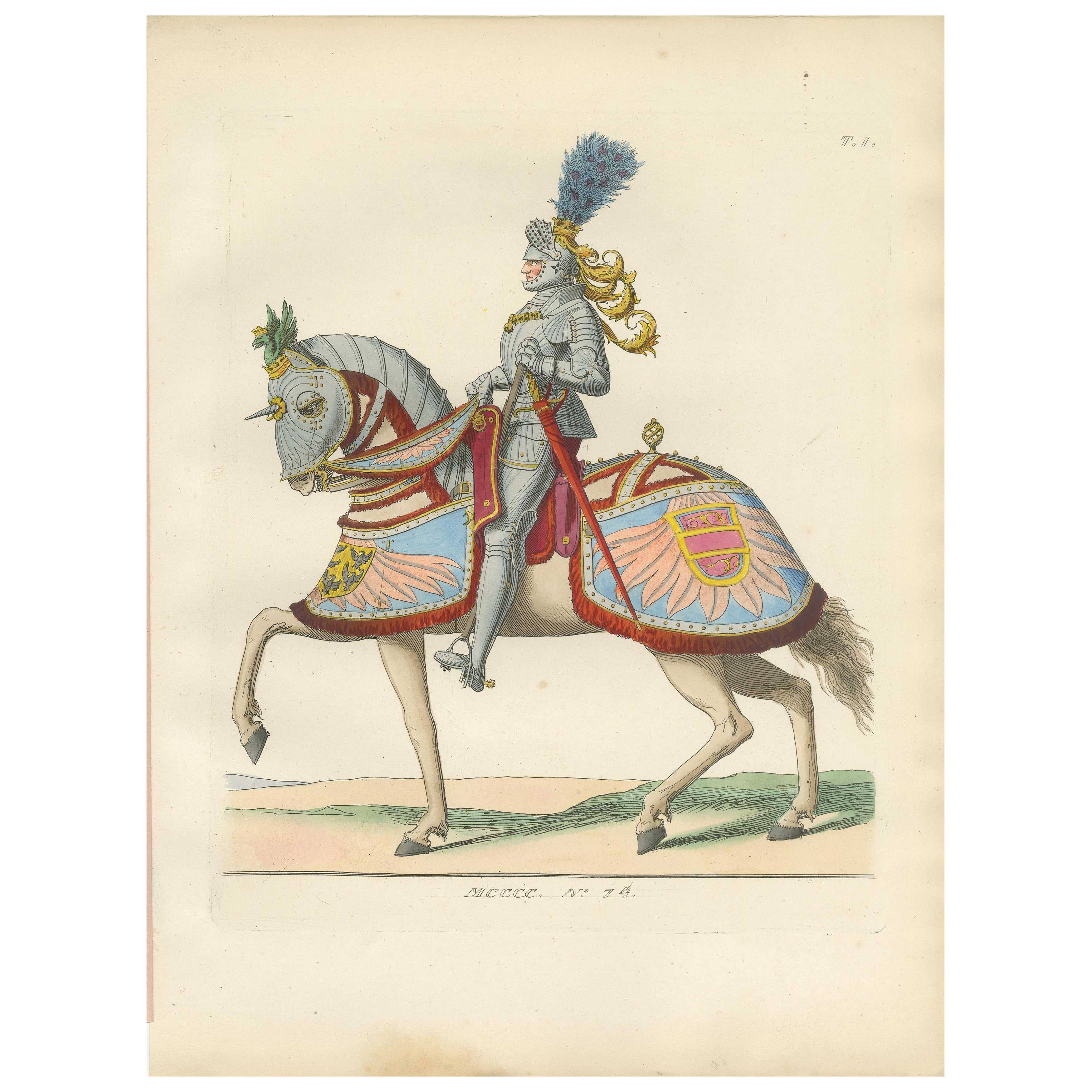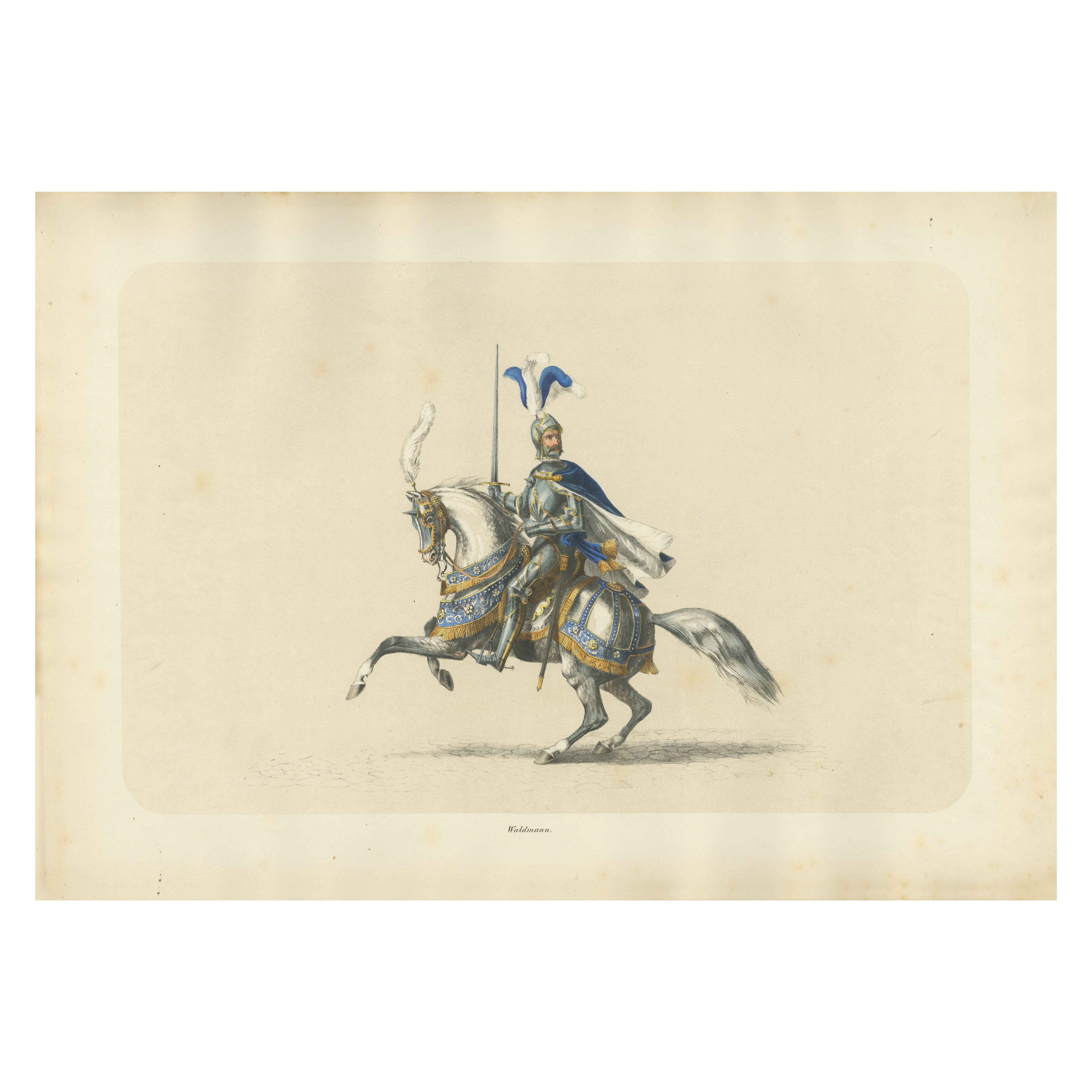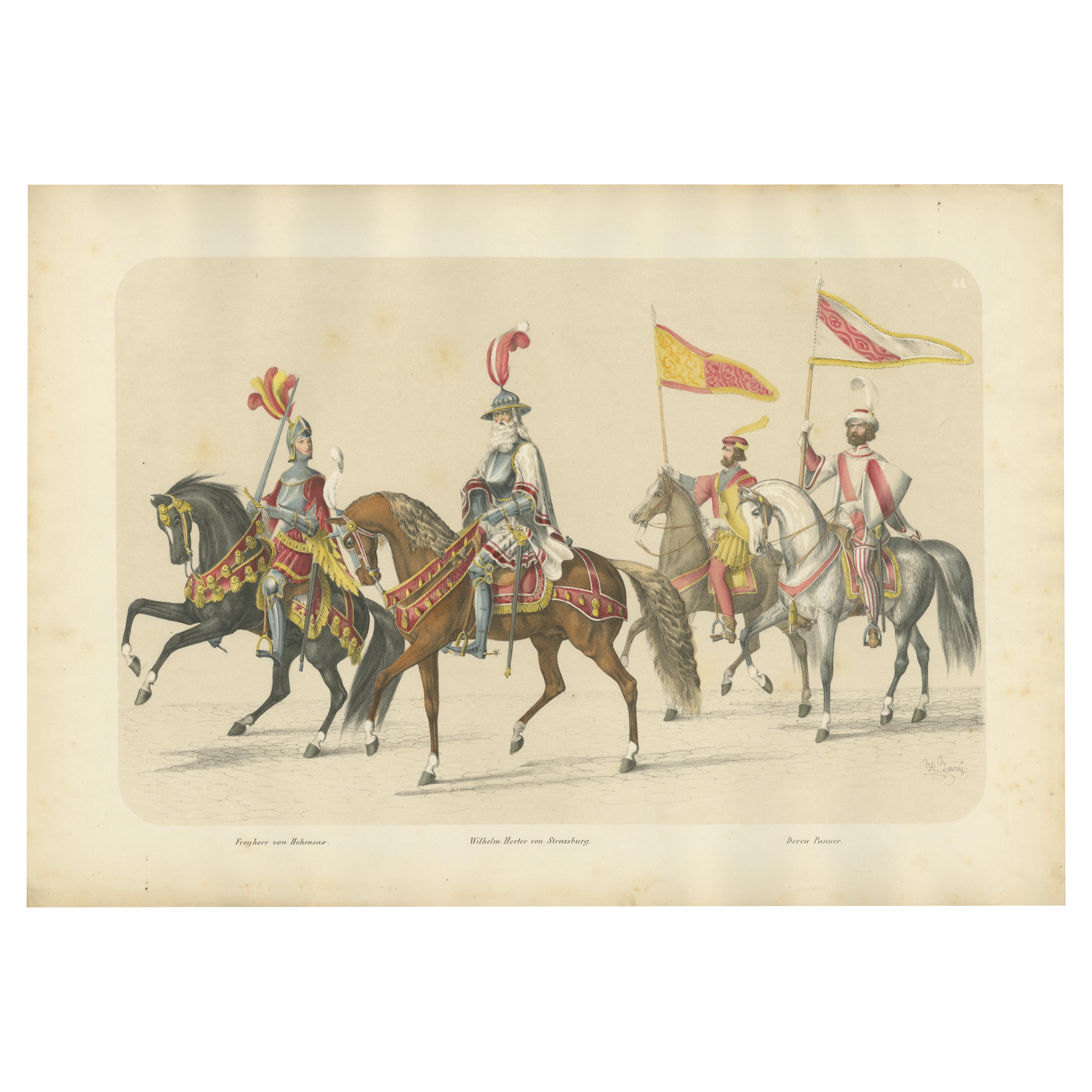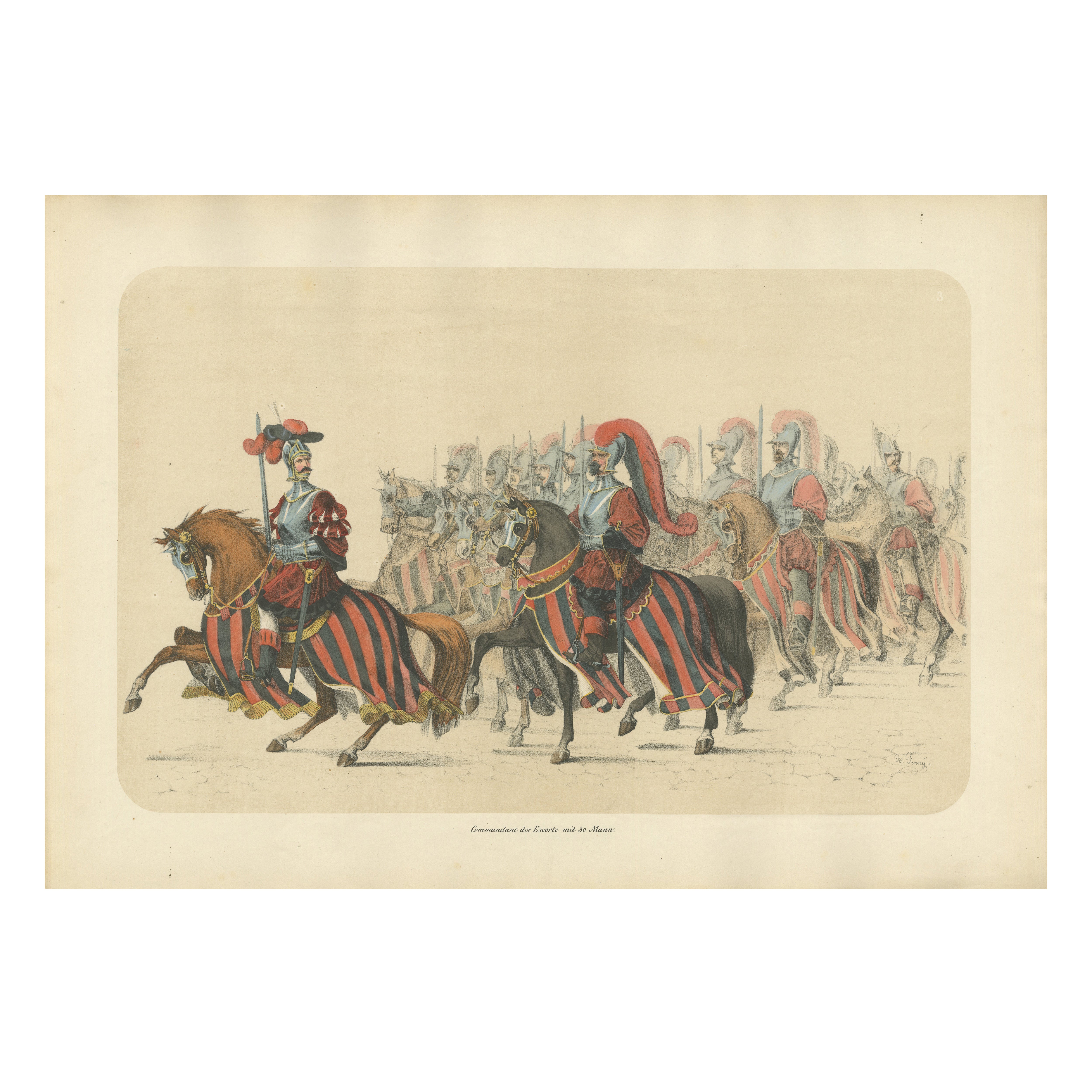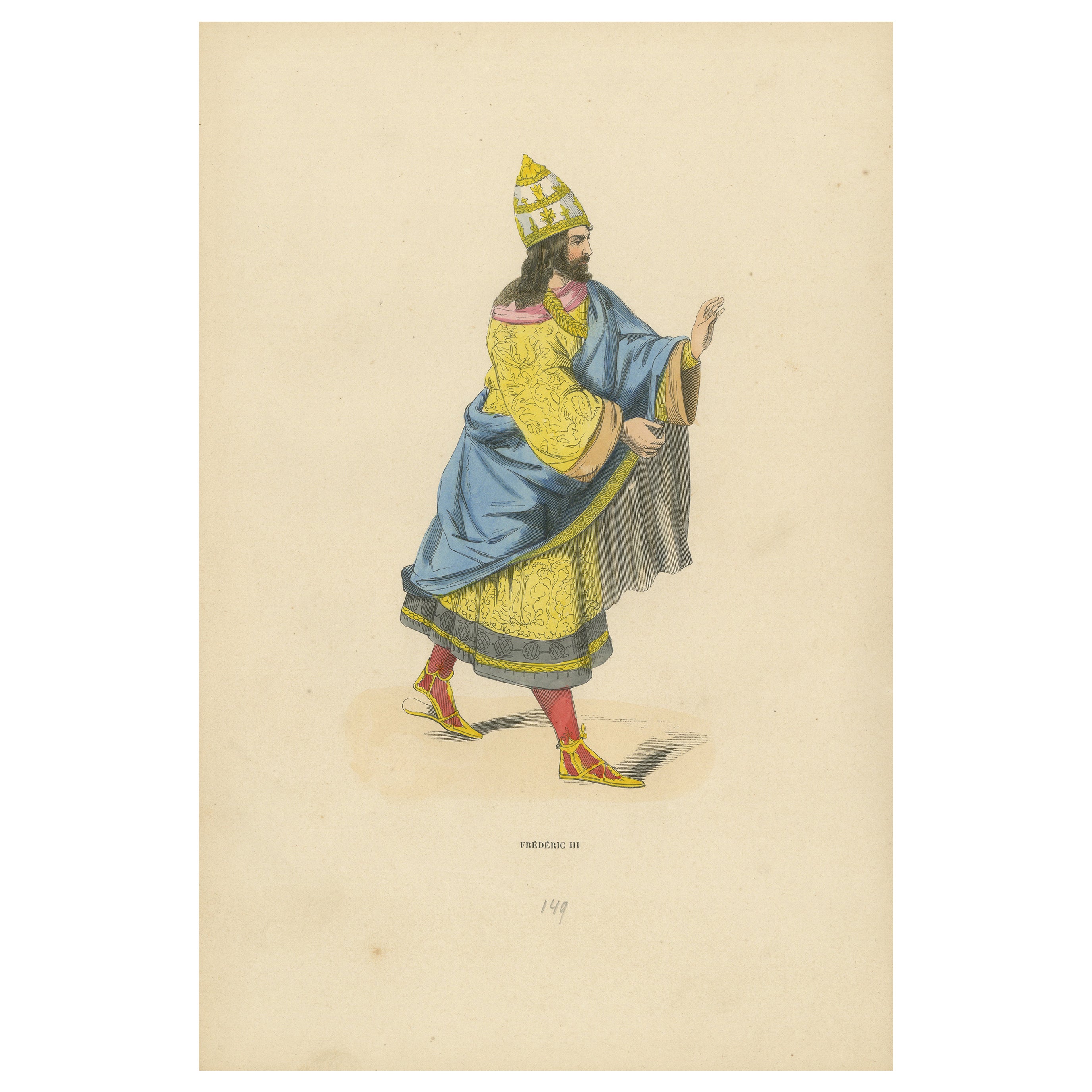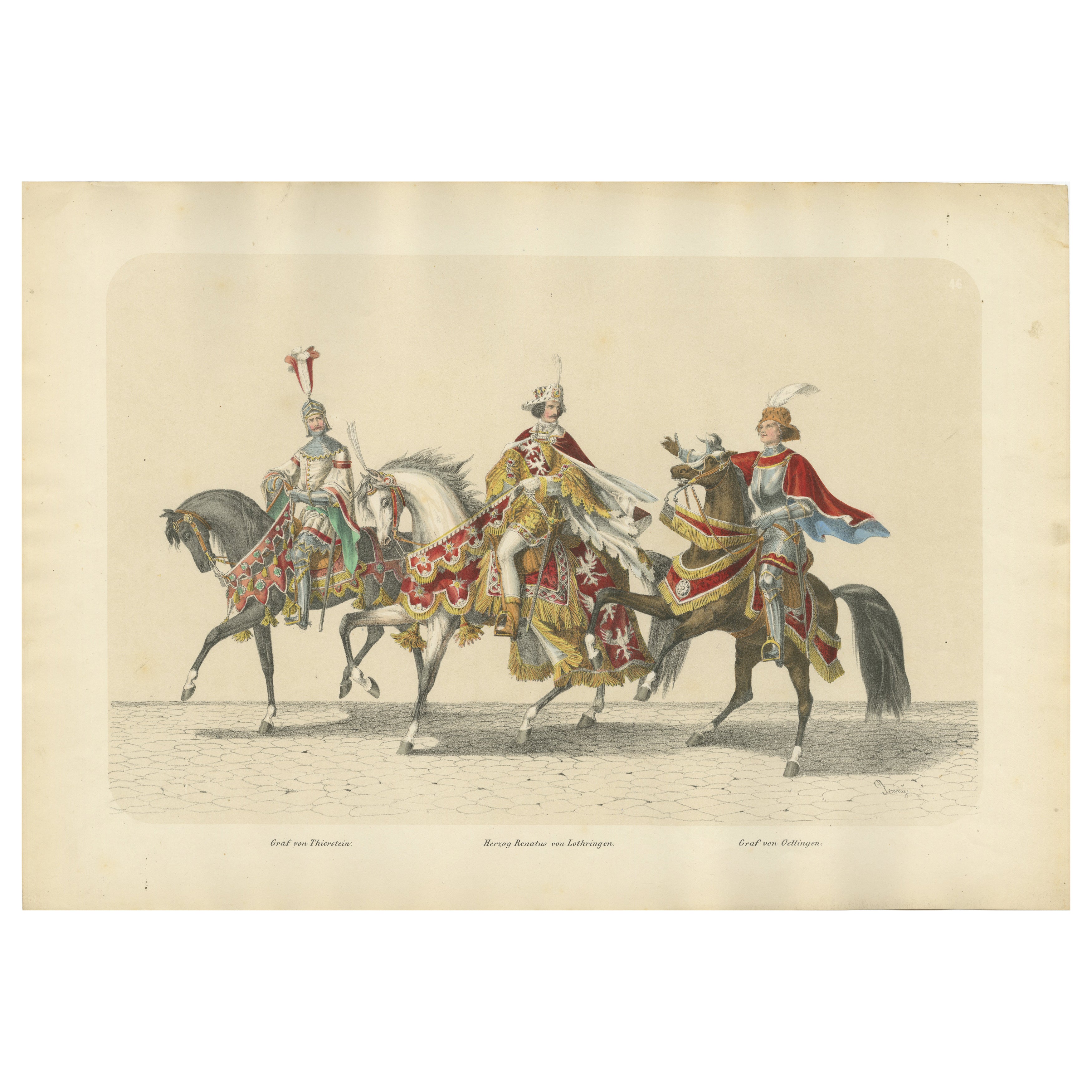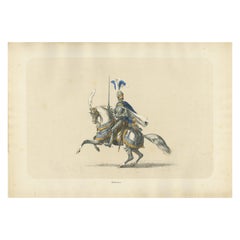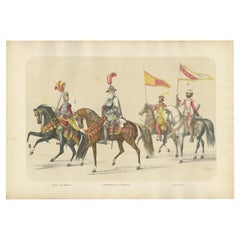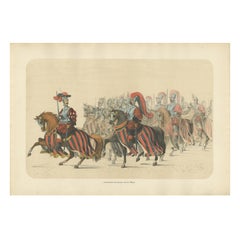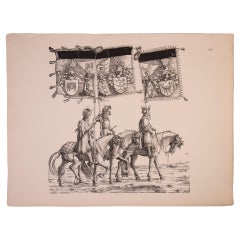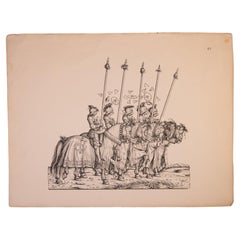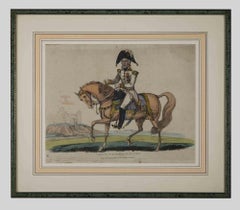Items Similar to Imperial Splendor: Emperor Maximilian on Parade, 1847
Want more images or videos?
Request additional images or videos from the seller
1 of 7
Imperial Splendor: Emperor Maximilian on Parade, 1847
$247.62
$309.5320% Off
£184.05
£230.0620% Off
€208
€26020% Off
CA$341.90
CA$427.3720% Off
A$379.14
A$473.9220% Off
CHF 199.21
CHF 249.0120% Off
MX$4,632.41
MX$5,790.5120% Off
NOK 2,492.37
NOK 3,115.4620% Off
SEK 2,339.51
SEK 2,924.3920% Off
DKK 1,583.82
DKK 1,979.7720% Off
About the Item
Title: "Regal Bearing: Emperor Maximilian on Parade"
Description: This historical illustration depicts Emperor Maximilian arrayed in full regalia, mounted on a proud and well-groomed steed. Maximilian, known for his pivotal role in European history, sits with an air of composed authority, reflecting his status as a ruler and a commander.
The Emperor's armor is detailed and functional, highlighted with elements that signify his imperial status. His helmet is adorned with a distinctive plume, signaling his high rank and adding to the pageantry of his appearance. The horse's caparison is resplendent, emblazoned with the heraldic colors and symbols associated with the Emperor, indicating his royal lineage and the vast territories under his reign.
Maximilian's posture, upright and confident, along with his hand resting on the pommel of his sword, is emblematic of his readiness to lead and defend his empire. The overall composition of the illustration, from the Emperor's regal attire to the horse's elaborate trappings, is a powerful representation of the majesty and the ceremonial splendor that surrounded the European nobility and their courts during the Renaissance. It's a window into the past, capturing the essence of the imperial power and the grandeur of the era.
The colors have a nice glow over them. Historically, egg whites, known as glair, and sometimes egg yolk were indeed used in illumination and painting, particularly in manuscripts, to give colors a brighter appearance and to add a sheen or gloss to the work. This technique was quite common during the Middle Ages and into the Renaissance.
Egg whites can be applied as a varnish over pigments to enhance their brightness and to protect the colors. This application could make the colors appear more vivid and also add a slight glossy sheen to the surface of the image.
Egg yolk, on the other hand, was commonly used as a binding agent in paint. It forms the basis of tempera paint, a medium that was widely used before the advent of oil painting. Egg yolk helps to create a durable and long-lasting color that adheres well to various surfaces.
In the context of the print from 1847, it's less likely that egg whites or yolks were used directly on the print, as by that time, commercial printing processes would have been more advanced and less reliant on such manual methods. However, if this print is a representation of an earlier style or is meant to mimic the appearance of hand-painted manuscripts, the original artists might have employed techniques or materials that gave a similar effect to those achieved with egg-based binders and varnishes.
- Dimensions:Height: 7.09 in (18 cm)Width: 10.63 in (27 cm)Depth: 0 in (0.02 mm)
- Materials and Techniques:
- Period:
- Date of Manufacture:1847
- Condition:Good. Overal light toning and light soiling but the image itself clean and hand-colored almost 200 years ago and still in expliciet colors. Aged paper with typically warm, yellowish-brown hue, mostly around the edges. Study the images carefully.
- Seller Location:Langweer, NL
- Reference Number:Seller: BG-13635-791stDibs: LU3054337906062
About the Seller
5.0
Recognized Seller
These prestigious sellers are industry leaders and represent the highest echelon for item quality and design.
Platinum Seller
Premium sellers with a 4.7+ rating and 24-hour response times
Established in 2009
1stDibs seller since 2017
2,609 sales on 1stDibs
Typical response time: <1 hour
- ShippingRetrieving quote...Shipping from: Langweer, Netherlands
- Return Policy
Authenticity Guarantee
In the unlikely event there’s an issue with an item’s authenticity, contact us within 1 year for a full refund. DetailsMoney-Back Guarantee
If your item is not as described, is damaged in transit, or does not arrive, contact us within 7 days for a full refund. Details24-Hour Cancellation
You have a 24-hour grace period in which to reconsider your purchase, with no questions asked.Vetted Professional Sellers
Our world-class sellers must adhere to strict standards for service and quality, maintaining the integrity of our listings.Price-Match Guarantee
If you find that a seller listed the same item for a lower price elsewhere, we’ll match it.Trusted Global Delivery
Our best-in-class carrier network provides specialized shipping options worldwide, including custom delivery.More From This Seller
View AllArmored Emperor Maximilian on Horseback in Ornate Renaissance Parade Dress. 1845
Located in Langweer, NL
Armored Emperor Maximilian on Horseback in Ornate Renaissance Parade Dress
This richly detailed hand-colored print, numbered MCCCC No.74, depicts Emperor Maximilian I in full ceremo...
Category
Antique Mid-19th Century French Prints
Materials
Paper
Festival Cavalcade – The Waldmann Knight in Majestic Parade, Published in 1855
Located in Langweer, NL
Title: 1855 Festival Cavalcade – The Waldmann Knight in Majestic Parade
Description: This magnificent hand-colored lithograph, created by H. Jenny and lithographed by Kümmerly an...
Category
Antique 1850s Prints
Materials
Paper
Grand Procession – Wilhelm Herter von Strasburg and the Lords of Bohemia, 1855
Located in Langweer, NL
Title: 1855 Grand Procession – Wilhelm Herter von Strasburg and the Lords of Bohemia
Description: This splendid hand-colored lithograph, created by H. Jenny and lithographed by K...
Category
Antique 1850s Prints
Materials
Paper
Commander with Escort – A Majestic Cavalry Procession from Bern’s 1853 Festival
Located in Langweer, NL
Title: Commander Leading the Escort – A Majestic Cavalry Procession from Bern’s 1853 Festival
Description: This magnificent hand-colored lithograph is part of the 'Fest Album Cel...
Category
Antique 1850s Prints
Materials
Paper
Imperial Majesty: Emperor Frederick III in 'Costume du Moyen Âge, 1847
Located in Langweer, NL
Title: "Imperial Majesty: Emperor Frederick III in 'Costume du Moyen Âge'"
Description: This lithograph from the "Costume du Moyen Âge" collection, printed in 1847, depicts Emperor ...
Category
Antique 1840s Prints
Materials
Paper
$133 Sale Price
20% Off
1855 Regal Cavalcade – Duke of Lorraine and the Counts of Thierstein & Oettingen
Located in Langweer, NL
Title: 1855 Regal Cavalcade – Duke René of Lorraine and the Counts of Thierstein and Oettingen
Description:
This striking hand-colored lithograph, created by H. Jenny and lithog...
Category
Antique 1850s Prints
Materials
Paper
You May Also Like
Engraving of Maximilian I° Roman Emperor "Knights in a Parade"
Located in Alessandria, Piemonte
ST/728-2. Engraving of Maximilian I°, Roman emperor, from the original engravings "The triumph of Maximilian " of the 16th and 17th centuries by Albrecht...
Category
Early 20th Century European Other Prints
Materials
Paper
Engraving of Maximilian I° Roman Emperor
Located in Alessandria, Piemonte
ST/728-1 . Engraving of Maximilian I°, beginning 1930, from the original engravings of the 16th and 17th centuries.
"Mounted knights in armour in a proce...
Category
Mid-20th Century Other Prints
Materials
Paper
Emperor of Austria - Original Lithograph - 1816
Located in Roma, IT
Emperor of Austria is an original print realized in 1816 ca.
Original mixed colored hand water-colored lithograph .
Title printed on plate on the lower margin.
Published by Richar...
Category
Early 19th Century Modern Figurative Prints
Materials
Watercolor, Lithograph
$541 Sale Price
30% Off
Le Impératrice Eugénie Lithograph, c.1850s
Located in Savannah, GA
A large hand-colored lithograph entitled “Le Impératrice, Compiegne,” after the painting by Jean Victor Adam (1801-1866), circa 1850s. Depicted is the Empress Eugénie de Montijo, wi...
Category
Antique Mid-19th Century French Other Prints
Materials
Glass, Wood, Paper
General of the Emperor’s Guards - Lithograph by Auguste Wahlen - 1844
Located in Roma, IT
General of the Emperor’s Guards is a lithograph made by Auguste Wahlen in 1844.
Hand colored.
Good condition.
At the center of the artwork is the original title "General des garde...
Category
1840s Modern Figurative Prints
Materials
Lithograph
Alexander Emperor - Original Lithograph - 1816 ca.
Located in Roma, IT
Alexander Emperor is an original print realized in 1816 ca.
Original mixed colored hand watercolor lithograph .
Title printed on plate on the lower margin.
Published by Richard Ev...
Category
Early 19th Century Modern Figurative Prints
Materials
Watercolor, Lithograph
More Ways To Browse
Horse Regalia
Antique Silver Boxes Repousse
Antique Storm Glass
Antique Thimbles
Antique Victorian Grandfather Clock
Antique Wooden Swan
Art Deco Bed Frame Queen
Art Deco Buffet Mirror
Art Deco Desk Statue
Art Deco Full Bed
Art Deco Glass Shelving
Astronomical Clock
Baker Dining Buffet
Baker Neoclassical Dining
Baker New World Collection
Baroque Headboard
Bear Bookends
Bi Discs
